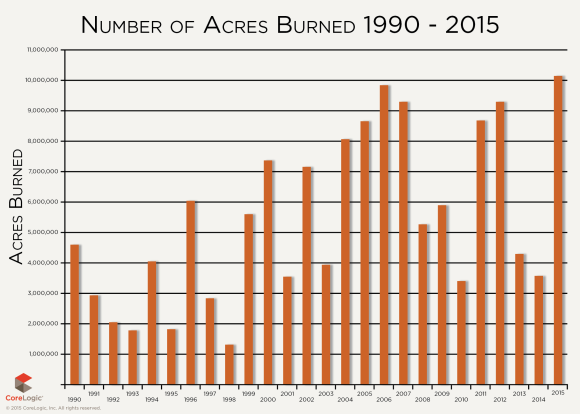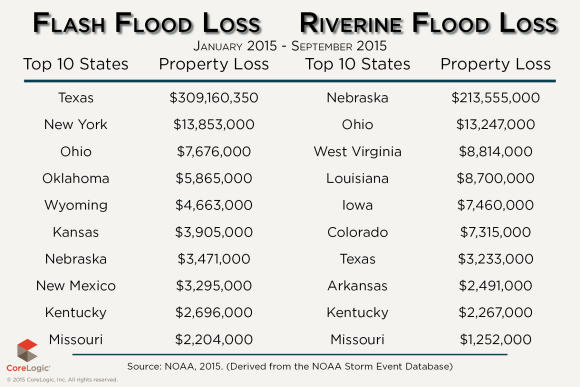This post is part of a series sponsored by CoreLogic.
Low-Level Hazard Activity Results in Decreased Damage and Loss Totals
Looking at the big picture, 2015 was a quiet year in terms of natural hazard activity. Overall, the trend of fewer natural hazard events and decreased damage totals that occurred in 2014 continued in 2015. However, if you ask the people of South Carolina, who were hit with record-setting 1,000-year rainfall that caused $1.5 billion worth of damage, they might say it was anything but quiet1.
Each year CoreLogic® analyzes and evaluates the number and severity of wildfire, flood, hurricane, wind, hail, tornado, earthquake and sinkhole events that occurred in the U.S. in its Natural Hazard Risk Report. Even though 2015 was a relatively low-activity year for hazard events, there were still record-setting wildfire and flood events that caused significant damage, as well as increases in earthquake activity that reveal important insight into changing dynamics for this peril.
Wildfire activity in 2015 was the worst in recorded history with more than 3.5 million acres burned in 2015, which is much higher than the total of 6,579,250 from the previous 15 years. This high level of wildfire activity had been expected for several years because of the drought in the western U.S., specifically in California, Washington, Oregon and Texas. Although areas that burned in 2015 are much less likely to have a wildfire return in the short term, the risk for wildfire in 2016 remains very high. According to CoreLogic data, 192,242 properties in the western U.S. are at very high risk of wildlife exposure with a total estimated reconstruction value (RCV) of almost $50 billion.

While the western U.S. struggled with drought, several central states experienced record-setting rainfall that resulted in flash and riverine flooding. These flood events were unique because none were storm surge related, but rather the result of strong and persistent rainfall. Based on the snapshot statistics from the National Oceanic Atmospheric Administration (NOAA) Storm Event Database, property losses from flash flood events in the first nine months of 2015 were more than 15 percent higher than the losses from riverine floods. For flash flood loss totals, Texas ranked first with property losses totaling more than $309 million, and New York ranked second with almost $14 million in property losses. For riverine flood loss totals, Nebraska ranked first with property losses totaling more than $213 million, and Ohio ranked second at just over $13 million.2

The record-setting 1,000-year rainfall in South Carolina, which was fueled by Hurricane Joaquin, led to riverine and flash flooding in 22 counties. The result was $1.5 billion worth of damage, including $587 million in agricultural losses, $181 million in insurance claims and $35 million in tourism losses1.
Atlantic hurricane activity in 2015 was below normal compared with previous years. As predicted, there were only 11 named storms, seven of which never grew stronger than a tropical storm. Of the four storms that were categorized as hurricanes, two were Category 1 and the other two grew into Major hurricanes: Danny, a Category 3 and Joaquin, a Category 4. While there weren’t any hurricanes that made landfall in 2015, and no substantial wind or storm surge damage occurred, storm-related precipitation from Tropical Storm Ana, Tropical Storm Bill and Hurricane Joaquin resulted in record-setting inland flooding. Despite the below-normal year for hurricane activity, recent offshore hurricane activity levels have been higher than during previous lulls in landfall storms.
Wind activity was also low in 2015, with the lowest recorded number of wind speeds of 65 mph or greater since 2006 when wind data collection began. Only 0.2 percent of the continental U.S. was affected by wind speeds of 80 mph or greater, and 31.5 percent of the continental U.S. experienced wind events of 60 mph or greater. Consistent with this data, anecdotal evidence from insurance carriers suggests that 2015 was a relatively quiet year for wind-related insurance claims.
Sinkhole activity was also low in 2015 with 2,206 new sinkhole events recorded across the U.S. The low-level sinkhole activity for the year could be related to the absence of landfall hurricanes. Landfall hurricanes bring significant rain that increases erosion of the subsurface layers and likewise increases sinkhole probability. Sinkholes can result from both natural and man-made causes in which the movement of water through soil acts as an erosive agent on underground layers of rock. Florida is the most well-known state for sinkholes because of its geological make up and has a total of 28,159 identified sinkholes according to CoreLogic data.
Hail activity was slightly above average in 2015 compared with previous years with 7.4 percent of the continental U.S. impacted by severe hail, which is defined as 1″ or greater. However, for hail sizes in which damage becomes prevalent – greater than 1.5″ – 2015 recorded the eighth lowest hail fall in the last 10 years. On June 15, multiple storms produced large hail and heavy rainfall across the far southern and southwestern Chicago metro area. Giant hail was observed near Minooka, IL, and the biggest hail reported measured 4.75 inches— the largest documented hail stone in Illinois since at least 19613. Still, anecdotal evidence from insurance carriers suggests that 2015 was a relatively quiet year for hail-related insurance claims.
With 1,252 recorded tornadoes in 2015, tornado activity in 2015 was higher than normal. Texas experienced the most tornado activity with 76 confirmed tornadoes. This is the most on record for north and central Texas since 1950 when the National Weather Service began tracking tornado activity.4
There was a total of 1,196 earthquakes of magnitude 3.0 or greater in 2015, slightly higher than average, although none produced significant property damage or loss. Oklahoma experienced four times more earthquakes than California and Oregon, two states that traditionally have among the greatest levels of seismic activity in the U.S. There has been an increase in the number of earthquakes in the central U.S. caused by induced seismicity, which is defined as not related to naturally occurring (tectonic) activity.5 Induced earthquakes in the U.S. can occur as a result of hydraulic fracturing or wastewater injection associated with natural gas exploration. This could explain why earthquake activity has increased in recent years, especially in Oklahoma, Kansas and northern Texas. Although earthquakes in Oklahoma occur more frequently, the majority are of smaller magnitude (M<4.0) than those in California so more property damage typically occurs there.5
From a numbers standpoint, 2015 was a quiet year for natural hazards with an overall low number of events and decreased property loss compared with previous years. However, that does not discount the isolated events that were devastating—to both people and property—across the nation. Will this temporary reprieve from devastating catastrophic hazard events continue in 2016? Unfortunately, there isn’t a crystal ball that predicts the future of hazard events; however, it is imperative to be prepared with both active response and a strong understanding of mitigation against natural hazard risk in a year with different outcomes.
© 2016 CoreLogic, Inc. All rights reserved.
About CoreLogic
CoreLogic (NYSE: CLGX) is a leading global property information, analytics and data-enabled services provider. The company’s combined data from public, contributory and proprietary sources includes over 4.5 billion records spanning more than 50 years, providing detailed coverage of property, mortgages and other encumbrances, consumer credit, tenancy, location, hazard risk and related performance information. The markets CoreLogic serves include real estate and mortgage finance, insurance, capital markets, and the public sector. CoreLogic delivers value to clients through unique data, analytics, workflow technology, advisory and managed services. Clients rely on CoreLogic to help identify and manage growth opportunities, improve performance and mitigate risk. Headquartered in Irvine, Calif., CoreLogic operates in North America, Western Europe and Asia Pacific. For more information, please visit www.corelogic.com.

SOURCES
- http://www.advisen.com/tools/fpnproc/fpns/articles_new_3/P/249978303.html
- https://www.ncdc.noaa.gov/stormevents/
- http://www.weather.gov/lot/15jun10
- http://www.spc.noaa.gov/climo/torn/STAMTS15.txt
- http://earthquake.usgs.gov/earthquakes/search
Topics Trends Catastrophe USA Texas Profit Loss Wildfire Flood Hurricane Property Oklahoma Earthquake
Was this article valuable?
Here are more articles you may enjoy.



 Supreme Court Overturns Chevron Rule in Blow to Regulators
Supreme Court Overturns Chevron Rule in Blow to Regulators  Farmers Adjusters Cry Foul Over Workloads, Claims Handling in Letter to Regulators
Farmers Adjusters Cry Foul Over Workloads, Claims Handling in Letter to Regulators  Three Charged With Helping Agents Cheat on Florida Insurance License Exams
Three Charged With Helping Agents Cheat on Florida Insurance License Exams  Home Insurance at $10,000 a Year Shows California Buyers’ Pain
Home Insurance at $10,000 a Year Shows California Buyers’ Pain 

